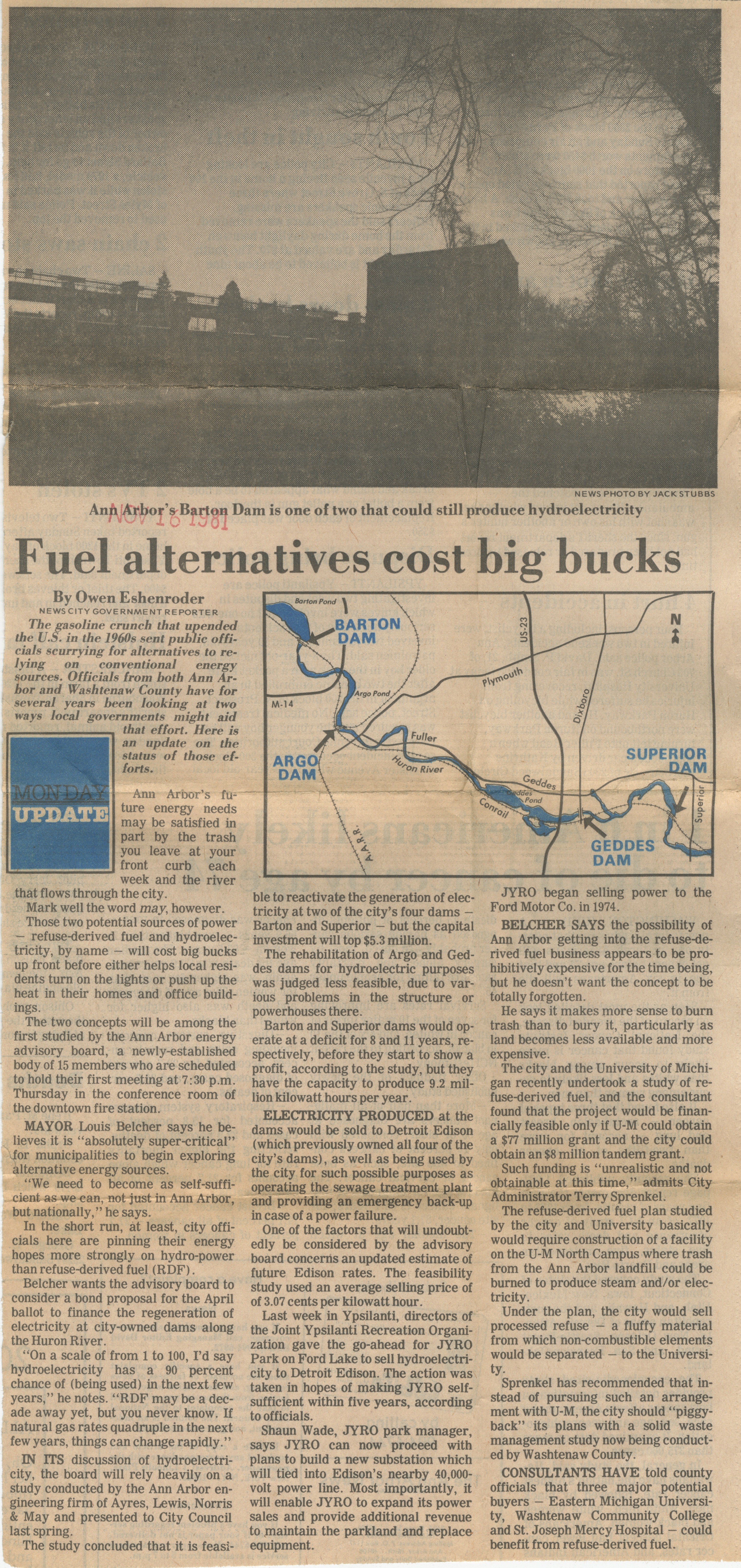Monday Update: Fuel Alternatives Cost Big Bucks

Ann Arbor's Barton Dam is one of two that could still produce hydroelectricity
NEW PHOTO BY JACK STUBBS
Fuel alternatives cost big bucks
By Owen Eshenroder
NEWS CITY GOVERNMENT REPORTER
MONDAY UPDATE
The gasoline crunch that upended the U.S. in the 1960s sent public officials scurrying for alternatives to relying on conventional energy sources. Officials from both Ann Arbor and Washtenaw County have for several years been looking at two ways local governments might aid that effort. Here is an update on the status of those efforts.
Ann Arbor’s future energy needs may be satisfied in part by the trash you leave at your front curb each week and the river that flows through the city.
Mark well the word may, however.
Those two potential sources of power - refuse-derived fuel and hydroelectricity, by name - will cost big bucks up front before either helps local residents turn on the lights or push up the heat in their homes and office buildings.
The two concepts will be among the first studied by the Ann Arbor energy advisory board, a newly-established body of 15 members who are scheduled to hold their first meeting at 7:30 p.m. Thursday in the conference room of the downtown fire station.
MAYOR Louis Belcher says he believes it is “absolutely super-critical” for municipalities to begin exploring alternative energy sources.
“We need to become as self-sufficient as we can, not just in Ann Arbor, but nationally,” he says.
In the short run, at least, city officials here are pinning their energy hopes more strongly on hydro-power than refuse-derived fuel (RDF).
Belcher wants the advisory board to consider a bond proposal for the April ballot to finance the regeneration of electricity at city-owned dams along the Huron River.
“On a scale of from 1 to 100, I’d say hydroelectricity has a 90 percent chance of (being used) in the next few years,” he notes. “RDF may be a decade away yet, but you never know. If natural gas rates quadruple in the next few years, things can change rapidly.”
IN ITS discussion of hydroelectricity, the board will rely heavily on a study conducted by the Ann Arbor engineering firm of Ayres, Lewis, Norris & May and presented to City Council last spring.
The study concluded that it is feasible to reactivate the generation of electricity at two of the city’s four dams -Barton and Superior - but the capital investment will top $5.3 million.
The rehabilitation of Argo and Geddes dams for hydroelectric purposes was judged less feasible, due to various problems in the structure or powerhouses there.
Barton and Superior dams would operate at a deficit for 8 and 11 years, respectively, before they start to show a profit, according to the study, but they have the capacity to produce 9.2 million kilowatt hours per year.
ELECTRICITY PRODUCED at the dams would be sold to Detroit Edison (which previously owned all four of the city’s dams), as well as being used by the city for such possible purposes as operating the sewage treatment plant and providing an emergency back-up in case of a power failure.
One of the factors that will undoubtedly be considered by the advisory board concerns an updated estimate of future Edison rates. The feasibility study used an average selling price of of 3.07 cents per kilowatt hour.
Last week in Ypsilanti, directors of the Joint Ypsilanti Recreation Organization gave the go-ahead for JYRO Park on Ford Lake to sell hydroelectricity to Detroit Edison. The action was taken in hopes of making JYRO self-sufficient within five years, according to officials.
Shaun Wade, JYRO park manager, says JYRO can now proceed with plans to build a new substation which will tied into Edison’s nearby 40,000-volt power line. Most importantly, it will enable JYRO to expand its power sales and provide additional revenue to maintain the parkland and replace equipment.
JYRO began selling power to the Ford Motor Co. in 1974.
BELCHER SAYS the possibility of Ann Arbor getting into the refuse-derived fuel business appears to be prohibitively expensive for the time being, but he doesn’t want the concept to be totally forgotten.
He says it makes more sense to burn trash than to bury it, particularly as land becomes less available and more expensive.
The city and the University of Michigan recently undertook a study of refuse-derived fuel, and the consultant found that the project would be financially feasible only if U-M could obtain a $77 million grant and the city could obtain an $8 million tandem grant.
Such funding is “unrealistic and not obtainable at this time.” admits City Administrator Terry Sprenkel.
The refuse-derived fuel plan studied by the city and University basically would require construction of a facility on the U-M North Campus where trash from the Ann Arbor landfill could be burned to produce steam and/or electricity.
Under the plan, the city would sell processed refuse - a fluffy material from which non-combustible elements would be separated - to the University.
Sprenkel has recommended that instead of pursuing such an arrangement with U-M, the city should “piggyback” its plans with a solid waste management study now being conducted by Washtenaw County.
CONSULTANTS HAVE told county officials that three major potential buyers - Eastern Michigan University, Washtenaw Community College and St. Joseph Mercy Hospital - could benefit from refuse-derived fuel.
Article
Subjects
Owen Eshenroder
Water Supply
Washtenaw County - Government
University of Michigan - Research
Superior Dam
Renewable Energy
Recycling Services
Public Utilities
Parks - Washtenaw County
Local Government
Joint Ypsilanti Recreation Organization (JYRO)
Hydroelectric Power
Huron River
Geddes Dam
Detroit Edison Company
Dams
Barton Pond
Barton Dam
Ayres Lewis Norris and May
Argo Dam
Ann Arbor Energy Advisory Board
Ann Arbor City Council
Ann Arbor - City Government Departments
Has Photo
Old News
Ann Arbor News
Terry Sprenkel
Shaun Wade
Louis Belcher
Jack Stubbs